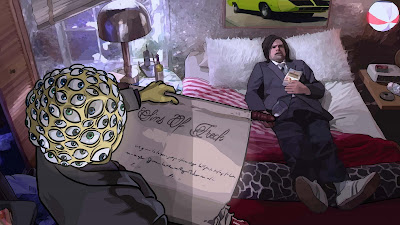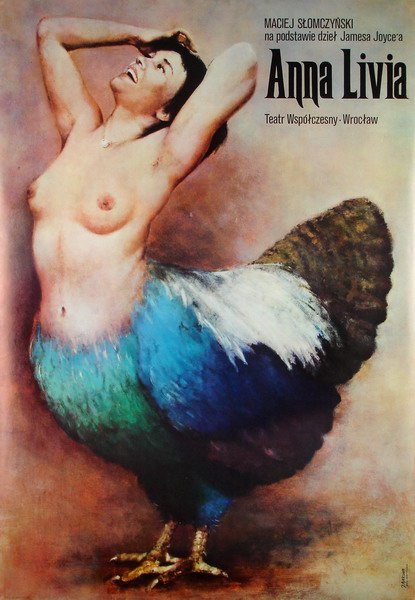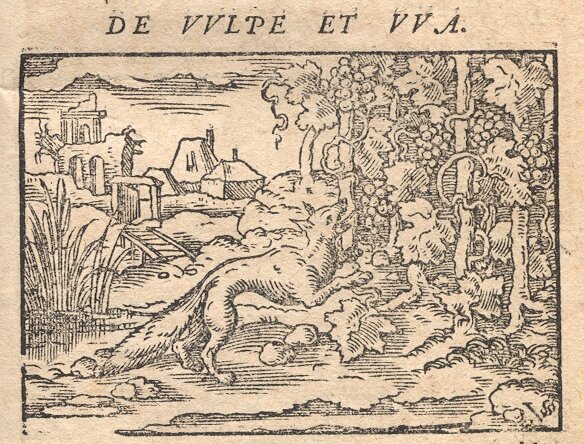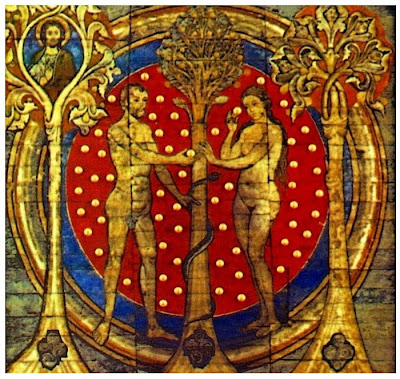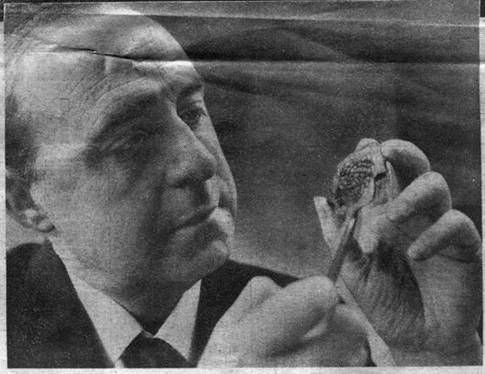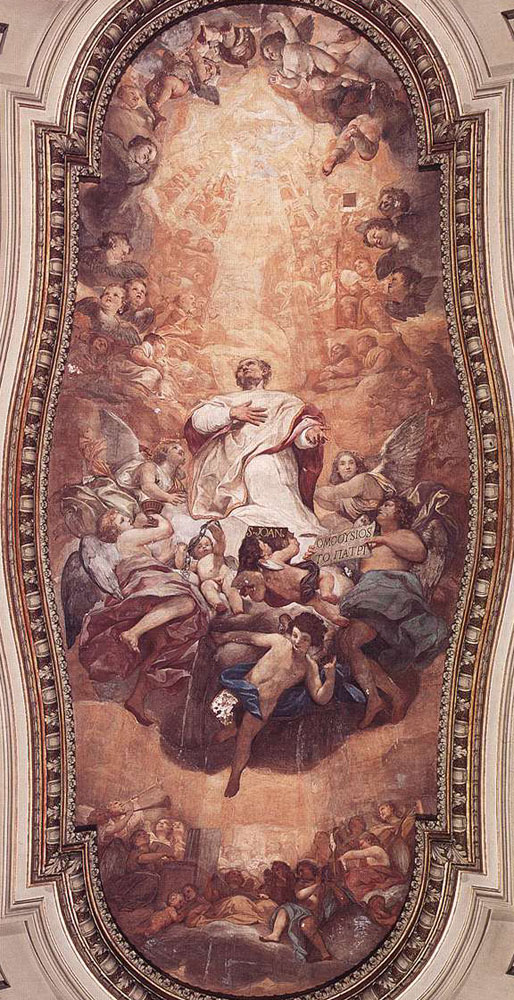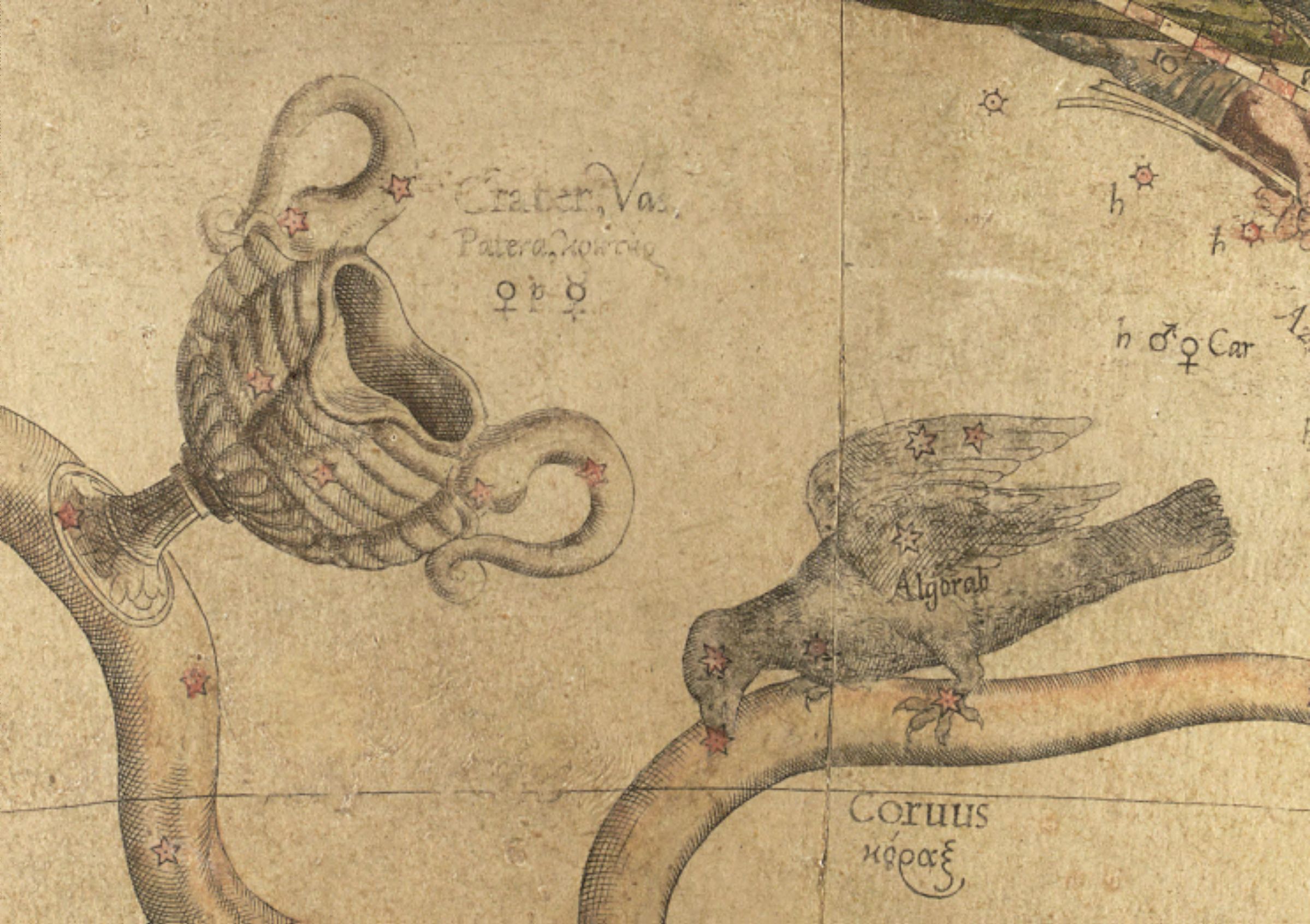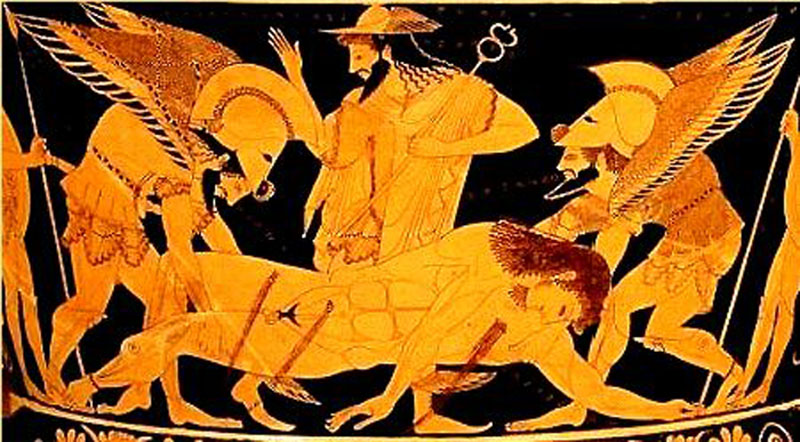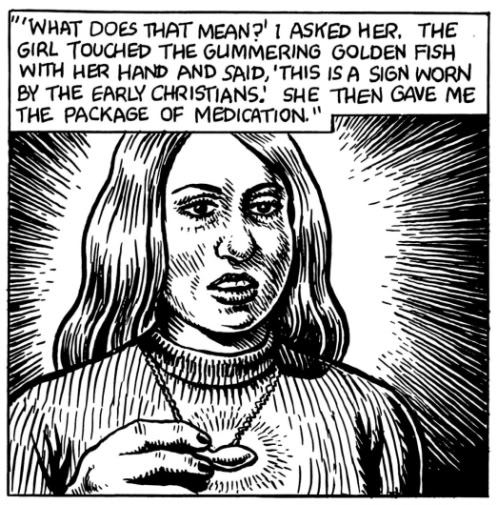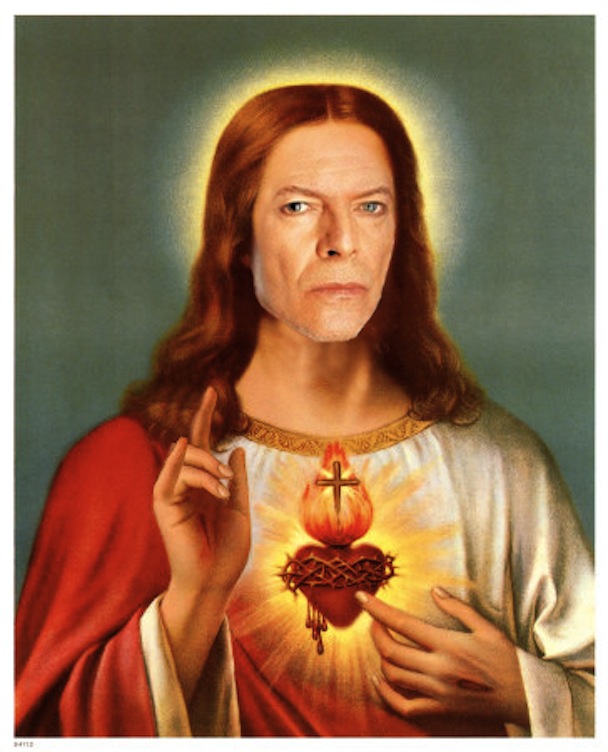
Beating Time
Philip K. Dick's question of "why me?" in regard to his experiences of 2-3-74 is huge, and is a question that might have direct bearing on what is happening right now. Before exploring that, though, it's vital to examine the nature and purpose of Pike's return. Dick is very clear about the reason for this.
Jim returned from the dead, out of compassion for "those he loved"—which is what I had wanted to write from the very beginning but did not know how, nor did I dare to! Inasmuch as Jim's (Tim's) return from the dead is identified with the presence of Christ in the Dead Sea Desert, it is expressed—like Christ's own resurrection—as a sign that the Parousia is here!
The return of Jim Pike was, in a sense is, the Parousia. He is the personalized embodiment of VALIS or Zebra. He is the homoplasmate -- that being which is the symbiosis of living information and the human. As the homoplasmate, Jim Pike's mission is to transubstantiate the world, is to shatter the illusory control of the Black Iron Prison, is to wake up humanity from the nightmare of history. And he is doing so out of compassion.
The most important realization of the Exegesis, perhaps its entire purpose, is that the message of The Transmigration of Timothy Archer is needed to complete the prior two books of the VALIS trilogy. The revelation of VALIS is not complete without this third book. And the purpose of this book is to tell of the bodhisattva -- that spiritually advanced individual who, out of compassion, forgoes his or her own entry into nirvana in order to first liberate all beings.
Tim comes back deliberately because he has learned that it all has to do with compassion: he is a bodhisattva and this concept—the bodhisattva—has to do with the Buddha. So the resolution of BTA is: Christ/the Buddha homologized as the bodhisattva... Thus the VALIS trilogy is ultimately resolved on this note: compassion.
Dick realized first Pike's compassion for himself. PKD's entire karmic debt was paid off by grace. He became entirely free of it. The sins of his past were totally forgiven. This is the ultimate act of compassion from either a Buddhist or a Christian perspective. In this, these two religions are in agreement. Dick states that his being forgiven can be looked at in two ways:
(1) My IOU was bought up, my debt paid for me (justification through grace).
(2) The huge stone gates of the fortress or prison— Klingsor's Castle—opened—parted—and in fact vanished; the maze was solved
by the pure fool—me.
Either the debt is paid off by an external source, the bodhisattva, or the illusion of indebtedness is ended. These are merely two facets of one truth. In Buddhism, the two are called karuṇā, or compassion, and prajñā, or wisdom. Of these, Dick seems to place more importance on the former. Only the pure fool is truly wise, and the pure fool already has compassion in his heart. In the Exegesis, Dick also calls the Black Iron Prison, the maze, and explains that compassion "is the only power capable of solving the maze."

This is the wisdom of the greatest spiritual teachers, the avatars, the homoplasmates. For Christianity, Buddhism, and other spiritual traditions,
...the ultimate paradox of the maze, its quintessential ingenuity of construction, is that the only real way out is a voluntary way back in (into it and its power), which is the path of the bodhisattva. The maze, then, is one colossal and absolute Chinese finger trap.
Dick further explains this paradox:
...when you think you are out of the maze—i.e., saved—you are in fact still in it. You only actually get out when you seem to be out, think you are out, and voluntarily decide to return!
The paradox becomes even more baffling when we consider our present lives. Why are we here? Is it possible that we voluntarily decided to reenter the maze in order to assist in the liberation of others? Are we, in other words, bodhisattvas without knowing it? Dick suggests that anamnesis, the absence of forgetting, can be equated here with nirvana. By remembering our true purpose, total compassion, we do not really escape the maze, but the maze itself is transformed into nirvana. This is very close to Blake's image of "wheels within wheels."

We who are here —or at least, some of us—were once in it before (in my case as Thomas), but we—or I—came back in and am here now. Thus my voluntary return to the maze has already happened, and 2-3-74 was true release. And hence for these reasons came in the form of restored memory—the loss of forgetfulness. Then I did not solve the maze this time; I had already solved the maze by voluntarily coming back in as PKD—and I remembered in 2-74. Thus my salvation was assured not by what I did in this lifetime but by this lifetime as such.
Dick's experiences of 2-3-74 were essentially an act of remembering. By anamnesis we solve the maze by remembering that we have already solved it, and by knowing that the maze has never really existed in the first place. PKD writes that there are then two ways to view the maze:
(1) it leads out (to Paradiso/nirvana)
(2) it leads in (to the Grail)
In the first case, the seeker attains nirvana, or heaven, but returns, like Dante, as a bodhisattva to help others. In the second case, perhaps even more compelling, the seeker ventures deep into the maze to find the Grail and the blood that it contains. On attaining this holy cup the whole nature of reality, of the maze, is instantly transformed. On finding the Grail, as in Parsifal, "time turns into space." Time is made visible and past, present and future appear at once. History becomes eternity.

This insistence that time itself is transformed, even transcended, in the experience recalls the "Ondt and the Gracehoper" episode of Finnegans Wake. It is only the playful, carefree grasshopper character who is able to "beat time." The thrifty and cautious ant, or ondt, is successful within the confines of the Black Iron Prison, but he is unaware that he is irredeemably trapped. The gracehoper is marginal and impoverished, but he is free. He hopes for, and does receive, grace.
Loop De Loop
A really intriguing take on the question of escaping from the maze is presented in the writings of Mark LeClair in the Wrong Way Wizard blog. LeClair is known in certain quarters for his idea of the "VALIS Loop." What he considers to be the actual mechanics of this Loop can be read about here and here, but I'd like to focus on how his concept apparently differs from PKD. LeClair explains Dick's perspective of the Loop:
In the Watergate era, sci-fi author Phillip K. Dick reported a vision. What he learned from this vision was that sometime around 70 or 80 A.D. a group of "Jewish Alchemists" had instituted a method of looping time back into itself on a sort of infinite historical playlist. The reason for this action was to forestall the return of Christ after the destruction of Solomon's Temple by the Romans. According to Dick, the Return of Christ is the promised end to a system of Sacrificial Agriculture originating with Cain, from the Book of Genesis, who is the Father of Agriculture, and ratified by Enoch, son of Cain, who is the Father of Satanic Alchemical Magick. These two systems (Agriculture and Magick) are the basis for the entirety of human social commerce and all the woe, inequality and royalty that comes with it. The return of Christ threatens to shatter this system which is so prosperous to an elite class of dignitaries.

LeClair, at the risk of misreading or simplifying him, goes on to say that Dick was only partly right. The would-be return of Christ is yet another turn in the Loop. It is fully accounted for in the Loop's program. Such an event, or at least the anticipation of it, would offer only a simulacrum of liberation to be closely followed by renewed suppression and control.
The duration of one loop is about 2000 years, but there is an overlap period of approximately 200 years between tape loops. In the course of this transitional phase "the intensity of feedback creates large scale pattern recognition among those imprisoned in the Loop."
This meshes very well with what Jung explained happens between astrological ages, and it dovetails with the concept of the 108-year cycle discussed in this blog.
During this time of "pattern recognition," presumably including synchronicity, paranormal occurrences, glitches in the Matrix, etc., things begin to become a little worrisome for the reigning "alchemists." The danger for them, if I get LeClair right, is that during this overlap period individuals are also able, in potential, to remember that they are immortal. They are able to break through the "illusion of death."
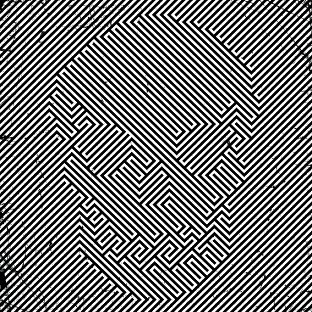
As within the Loop the number of souls/personalities are finite, death does not really take place, only a type of recycling or reincarnation occurs. Of course, a population which does not fear death is a population which is uncontrollable. To prevent this loss of fear and delusion, preemption and distraction are required.
The key preemptive event in the present transitional period was 9/11. It deeply shocked those members of the population most capable of fully waking up. It provoked a mass quest to find answers, and ultimately it fostered a turn or return to mysticism.

For LeClair, mysticism is anything that directs our attention towards future salvation. It is the emphasis on the future which is most important for the wardens of the BIP. By focusing on things to come we lose our chance to become fully aware, to awaken to the truth of our immortality, in the overlap period. Dick's anamnesis, therefore, is incomplete and illusory. The Loop goes on.
Let's ride PKD's Valis Loop once more. According to Phil, prior to Watergate, the Alchemists had total control. Through the practice of eldritch rituals not at all to the taste of Joe Six-Pack, these Mages forestall the second coming of Christ forever. The New Age never arrives. Instead, the old age is repackaged, renamed and vigorously remarketed and the Land of the Dead lives on. On Watergate, the levee sprung a leak. This fizzle in the dyke was the source of Phil's revelation of anamnesia, but not much else. PKD's vision didn't change anything. We hover in a bubble of time, just as always. A flashing swath of plasma in the arc of a diver. Going, going, gone. Christ will never come. We are truly lost.
This all sounds very dire. Admittedly, I've only dipped a toe into the deep, dark waters of the Wizard, and I have no idea where discussions of these ideas have led to previously. I'm compelled by what LeClair writes, but I can't say that I fully understand it. It seems to me, though, that he does suggest a way out of the Loop, out of the maze, and it is a way that is not really that dissimilar to what Dick was writing about. There is a genuine anamnesis for LeClair as well. It consists of remembering that there is no real death.

Whether or not this can only be fully remembered during the overlap period is another question, but it seems to show a way out of the maze. Perhaps a mass realization like this would not end the Loop, but it would totally transform it in a Blakean manner. An Empire would have no control over such a population. LeClair writes that in a world of self-realized immortals "everyone is equally powerless." Obviously this means that everyone would be equally powerful as well. This takes us to the same place as Dick.
LeClair's warnings against future-based mysticism (and we must ask if all mysticism is really this) should be well heeded. Such systems of thought are used as devices for further control and distraction, but they can also liberate as well. Even disinformation necessarily contains grains of the truth. Dick's conviction that a bodhisattva-like being, or beings, has arrived out of compassion to free us from the maze, within the maze, is not so different than LeClair's suggestion of the possibility of realizing our own immortality.
To do this, though, LeClair is absolutely right. The end of history does not come in the future, but right now. The paradox is, while having this realization, that neither past nor future exist at all. Time is beaten.
Lines of Flight
Dick's later emphasis on wisdom, compassion, the bodhisattva, and nirvana sounds like straightforward Mahayana Buddhism. It's my belief, though, that Dick is presenting something quite different, something far closer to the Gnosticism of the Dead Sea and Nag Hamadi scrolls, but with a modern or postmodern overlay.
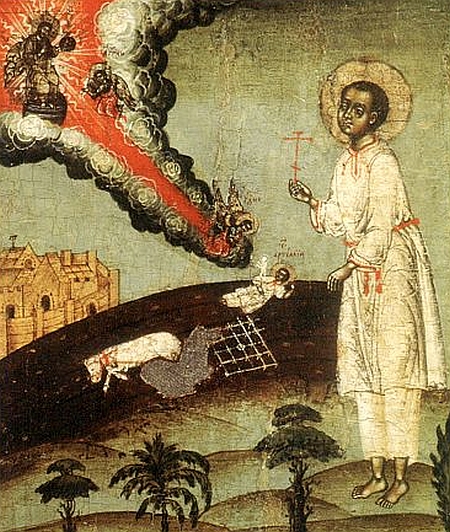
Buddhism is almost entirely non-dualistic (although it is built on a system of Two Truths -- one relative and one absolute), and while this is beneficial for personal liberation it is inadequate to deal with the injustices of history and the ongoing oppression by the ruling class. This requires opposition, a temporary dualism -- a dualism that would lead to eventual non-dualism. Of course this is again paradoxical and would seem to take us to the same bullshit, future-based mysticism that LeClair warned us against.
Blake also recognized this paradox within his Orc cycle, but it is a paradox that is necessary to overcome. Individually we might become awakened, following a Buddhist or similar spiritual path, but we would still dwell within the Empire. It is not enough to say that the Empire is also a necessary part of the universe. The Empire is a key source of suffering and to be truly compassionate we must try to end the suffering it creates.
The Gnosticism which Dick shares is historically unique. It really did not exist fully until after the various texts were rediscovered in the Forties. Gnosticism was known before this but it was always presented in the terms and biases of its foes, which were later inverted by the proponents of this counter-tradition.

Only in the last century, and really only after translations were extensively published in the Seventies, could we study Gnosticism in depth and in its own words. Dick's primary insight that living information had been revealed is profound and necessary. As Dick states several times in the Exegesis,
And everything is there, but only when all 3 volumes [of the VALIS trilogy] are read.
What this means, though, is that it really takes the Exegesis, a word meaning interpretation or explanation, to present this connection to the reader. The Exegesis itself is the missing link between the three books, and it was not substantially published until 2011.

This nearly completes the line of transmission: from the Gnostics and Essenes of the ancient Middle East, to the rediscoverers of the scrolls in the 1940s, to John Allegro, to James Pike, to Philip K. Dick, and finally through his Exegesis published in 2011, to fans of a pop culture now saturated in Dick. Perhaps it is only now that Zebra is fully stepping out of the grass.
Dick's ideas of a collective transformation, a physical transubstantiation, a divine invasion are only becoming widely understood, and experienced, at the present moment. The upwelling fascination and exploration in synchronicity, particularly since the widespread advent of Web 2.0, is certainly a part of this. Dick predicted that the invasion would happen in a time of "information slates" and off-world colonies. We now have tablets and roving probes on Mars, but this would seem to be the time he foresaw.

Highbrow Darth Vaders
It is likely, though, that Dick would be the first to admit that this is not the only line of transmission. As in Ubik, the invasion would be ubiquitous, appearing everywhere. It is worthwhile, then, to search for other possible manifestations of the unfolding parousia.
Carl Jung's Red Book was similarly only published in 2009. Before that only a couple dozen people had seen it. This book reveals Jung's explorations of the "active imagination" and significantly, an extensive article printed in the New York Times after the book was published was entitled, "The Holy Grail of the Unconscious." Another manifestation of the Grail.

I've mentioned before in this blog that in 2012 the books of James Joyce went into the public domain. Once carefully protected by tweedy scholars and Joyce's uncooperative and aloof grandson, Stephen, we can finally say, as Joyce surely wanted, "here comes everybody."
The New Yorker posted an article in January of 2012 called, "Has James Joyce Been Set Free?" It compares the entry of Joyce into the public domain with the climax of Star Wars.
The passage into public domain of Joyce’s major works has been talked up in certain quarters as though it were a bookish version of the destruction of the Death Star, with Stephen Joyce cast as a highbrow Darth Vader suddenly no longer in a position to breathe heavily down the necks of rebel Joyceans.
It's interesting to consider that Joyce's idea of the monomyth, through Joseph Campbell, was explicitly used by George Lucas in his construction of the Star Wars stories. Is this journalist aware of this connection and, if so, is he they aware how deeply appropriate this metaphor really is? But is it hyperbole to suggest that Joyce's writing could bring down the Empire? Perhaps not.

Qwaking the Middle Kingdom
On Christmas Day, 2012, just four days after the apparent non-apocalypse of Dec. 21st, a major blow against tyranny was struck in China. This was brought to my attention by the highly recommended "Finnegans, Wake!" blog. On Dec. 25th the first ever Chinese translation of the first book of Finnegans Wake was published in China. Due likely in a large part to a massive publicity campaign (16 large billboards in Shanghai alone!), it became a bestseller over the next month. The initial 8000 book print run quickly sold out and new prints are expected soon.

The translator, Joycean scholar Congrong Dai, has a fascinating story of her own -- a story that makes me conclude that this translation is certainly part of the revelation of Zebra. In an interview she explains her motivation for the translation:
I realized that Finnegans Wake was a really great book, and that this book can change the idea of Chinese reader. ... For me, Finnegans Wake is a book of freedom. I do not only mean political freedom. For example, Joyce will create new words to transcend social constraints. So the making of a new word shows Joyce’s disobedience and refusal of society.
For Dai it is the creation of new words that leads to freedom -- both political and social. She clearly understands the revolutionary nature of the text, and she is well aware of the ability of puns in Chinese to subvert the official party line and to bypass censorship. The Wake will obviously only facilitate this. Later in the interview, though, she admits something far more profound. She suggests that the Wake is alive and conscious, and that it somehow was even aware of her.

My name, Congrong, will be written as [the letters] C O N G and R O N G. This is two Chinese characters. On page 167 you can find the C O N G and after several lines you can find the R O N G on the same page. Ah! It's amazing. I think Joyce is saying that he can foretell something in his book. I think, wow, he knew some day that I will translate this.
Sure enough, on page 167 one can read on line 16:
...and wannot psing his psalmen with a cong in our gregational...
And this is followed on line 32 by:
...as young as your grandmother! The ring man in the rong shop...
In an article submitted to the James Joyce Quarterly, Congrong Dai confesses that "Wakean serendipitous coincidences" made it possible for her to continue the difficult translation. Wow! She was led by synchronicity. Her work was foretold by Joyce. Obviously she is meant to sing her psalm. Is she the vessel by which Zebra invades and transforms China?

For me, the fact that the first book of the Wake was translated into the language of the most populous country on Earth, where it became a run away bestseller, by a woman who is convinced of its ability to free her compatriots, a woman who feels called by the Wake itself, is enough evidence to be convinced that the 2012 singularity really did take place! Four days after the deadline is close enough.
Avalokiteśvara's Cat
One other golden Joyce nugget was unearthed in 2012. For the first time his children's book, The Cats of Copenhagen, was published by Ithys Press. The name of this publisher will take on deep relevance later, but it's also crucial to look at the content of the book. It has been called irreverent and anti-authoritarian. Joyce's anarchist sympathies are well known to his fans. Does the release of this book last year also signify a strike against the Black Iron Prison?
On top of this, the apparent Joycean nod to Schrödinger's cat and the Copenhagen interpretation of quantum mechanics takes the themes of ambiguity and uncertainty to the most foundational, physical level.

In just under a five-year period, then, The Red Book and The Exegesis have been published for the first time, and Joyce has been released into the public domain coinciding with the Chinese translation of the Wake and the publishing of The Cats of Copenhagen. Could all of this be the plasmate, alien living information, attempting to communicate and transform the world?
In the years from 2009 to 2013, the unleashing of new material by these three authors will eventually catalyze a massive expansion of the collective imagination. If this is not VALIS then, perhaps coincidentally, it will have much the same effect on humanity as if it was.
And yet these are only three authors, although three of the greatest, of hundreds to publish in the last half decade. And this includes only books. What discoveries, art works, movies, technologies and on and on have also appeared for the first time during this period? How have they altered the imagination of humanity? Are they, too, VALIS?
Let's assume for the moment that VALIS is here, and nearly everything is "in the invisible process of turning into the Lord." Would this mean that this is the only process occurring? As in many of Dick's books (The Divine Invasion, Ubik, etc.) could there be two completely opposite and opposing processes happening simultaneously? Or, more sinisterly, could these two be identical? Is VALIS the Black Iron Prison, or alternatively is the BIP interchangeable with VALIS?

Throughout this study the themes of inversion and ambiguity have come up again and again. Sirius seems to represent this -- both VALIS and Belial are said to have come from this same star. This raises the possibility of the two being one entity -- again, Christ and Lucifer both as the Morning Star. In The Transmigration of Timothy Archer, this ambiguity again arises.
At one point in the book Timothy Archer proposes a new theory that Satan's main sin was that he loved God too much:
I see the legend of Satan in a new way. Satan desired to know God as fully as possible. The fullest knowledge would come if he became God, was himself God. He strove for this and achieved it, knowing that the punishment would be permanent exile from God. But he did it anyhow, because the memory of knowing God, really knowing him as no one else ever had or would, justified to him his eternal punishment. Now, who would you say truly loved God out of everyone who ever existed? Satan willingly accepted eternal punishment and exile just to know God-by becoming God-for an instant.
Satan is punished for eternity because he loved God so much that his desire to know God caused him to become God. We might ask, though, after once becoming God does one ever really cease from being God? And this leads to to the ultimate heresy -- is Satan God?

Such a heresy is addressed towards the end of the book. Angel (and the name is no coincidence) accuses Bishop Archer, in his mad drive to discover the true origin of Christ, of becoming like his own idea of Satan.
"I need that wisdom, Angel. Nothing less will do."
"You are like Satan," I said, and then realized that the gin had hit me in a rush; I had not meant to say that.
"No," Tim said, and then he nodded. "Yes, I am. You're right."
In this short passage a lot is revealed. Bishop Timothy Archer is Bishop James Pike is VALIS. If he is also Satan then, by extension, is the whole process that Pike initiates including Dick, including the Exegesis, including his interpretation of the Wake, including sync, even including this post right now, Satanic? We can't be sure that it is not, but we also can't be sure of the nature of Satan.

Another inversion or ambiguity within Dick's writing may help us with these questions, or they may add to our confusion. In Dick's experiences of 1974 and onward, the entity which speaks to and/or through him is sometimes viewed as being male, like King Felix, Jim Pike, Thomas, etc., and sometimes as a female, like the Sibyl, Sofia, the Shekhinah, and so on. Is this entity actually several individuals? Or does this being alternate between genders? Or does it transcend gender altogether?
Certainly, gender transformation of advanced beings occurs often in various traditions. The bodhisattva, Avalokiteśvara, is generally portrayed as being male in India, and yet she is Kannon in Japan. Male and female exist at once. Dick's visions are really not that strange in this regard. But do these figures also combine and/or transcend our notions of good and evil? Are they both and neither at the same instant? Maybe the Wake can provide us with some lucid obscurity yet again.

HCE and ALP dream together, but only ever-flowing ALP is truly whole. HCE is always divided in conflict between his two sons, Shaun, or Christ, and Shem, or Satan. Only by first integrating these two can HCE ever hope to successfully unite with ALP. All of these forces are at dance and play. All have returned.


